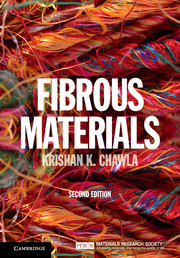Book contents
- Frontmatter
- Dedication
- Contents
- Preface to the Second Edition
- Preface to the First Edition
- Acknowledgments
- 1 Introduction
- 2 Fibers and fibrous products
- 3 Natural polymeric fibers
- 4 Synthetic polymeric fibers
- 5 Electrospun fibers
- 6 Metallic fibers
- 7 Ceramic fibers
- 8 Glass fibers
- 9 Carbon fibers
- 10 Experimental determination of fiber properties
- 11 Statistical treatment of fiber strength
- Appendix: Some important units and conversion factors
- Indexes
- Plate section
Preface to the First Edition
Published online by Cambridge University Press: 05 June 2016
- Frontmatter
- Dedication
- Contents
- Preface to the Second Edition
- Preface to the First Edition
- Acknowledgments
- 1 Introduction
- 2 Fibers and fibrous products
- 3 Natural polymeric fibers
- 4 Synthetic polymeric fibers
- 5 Electrospun fibers
- 6 Metallic fibers
- 7 Ceramic fibers
- 8 Glass fibers
- 9 Carbon fibers
- 10 Experimental determination of fiber properties
- 11 Statistical treatment of fiber strength
- Appendix: Some important units and conversion factors
- Indexes
- Plate section
Summary
This book is about materials in fibrous form, precisely what the title says. Perhaps the only thing that needs to be emphasized is that the materials aspects of fibers are highlighted. The main focus is on the triad of processing, microstructure, and properties of materials in a fibrous form. I have kept the mathematics to the bare minimum necessary. More emphasis is placed on physical and chemical insights. Although all kinds of fibers are touched upon, there is a distinct tilt toward synthetic, nonapparel-type fibers. This is understandable inasmuch as the second half of the twentieth century has seen tremendous research and development activity in this area of high performance fibers, mainly for use as reinforcement in a variety of matrix materials.
The field of fibrous materials is indeed very vast. To compress all the information available in a reasonable amount of space is a daunting task. My aim in writing this text has been to provide a broad coverage of the field that would make the text suitable for anyone generally interested in fibrous materials. I have provided ample references to the original literature and review articles to direct the reader with a special interest in any particular area.
The plan of the book is as follows. After an introductory chapter, some general terms and attributes regarding fibers and products thereof are described in Chapter 2. This chapter also serves to provide a mutually comprehensible language to textile and nontextile users of fibers. There is no gainsaying the fact that many definitions, units, and terms about fibers owe their origin to the textile industry. Thus, it behooves a materials scientist or engineer to take cognizance of those and be at home with them. At the same time, it is not unreasonable to expect that a textile engineer should know the stress–strain curves of fibers in engineering units. This general chapter is followed by Chapters 3 and 4 on natural and synthetic polymeric fibers, respectively. Chapter 5 covers metallic fibers, which are quite widely used in a variety of engineering applications, although generally not so recognized. Chapter 6 describes ceramic fibers where much innovative processing work has been done during the last quarter of the twentieth century.
- Type
- Chapter
- Information
- Fibrous Materials , pp. xiii - xivPublisher: Cambridge University PressPrint publication year: 2016



